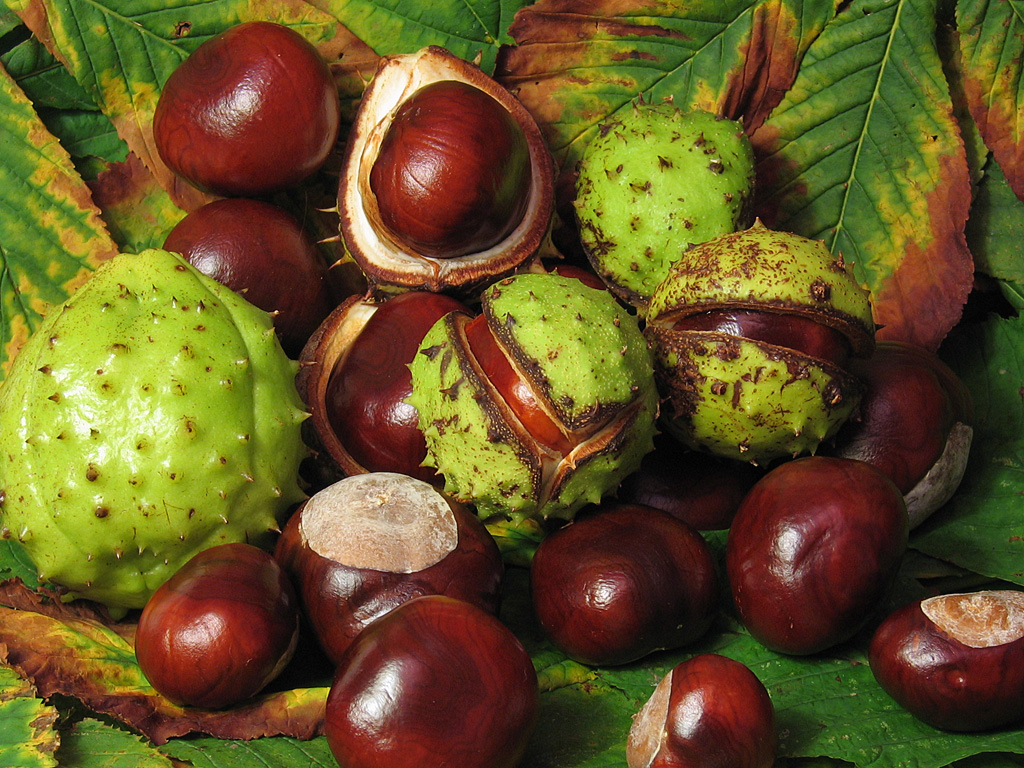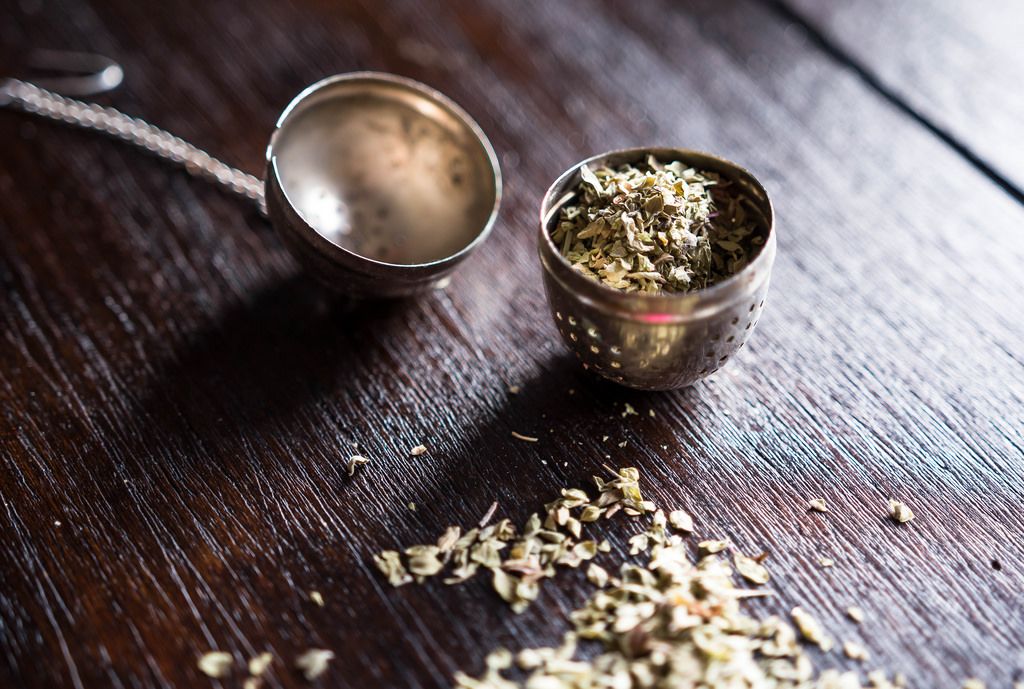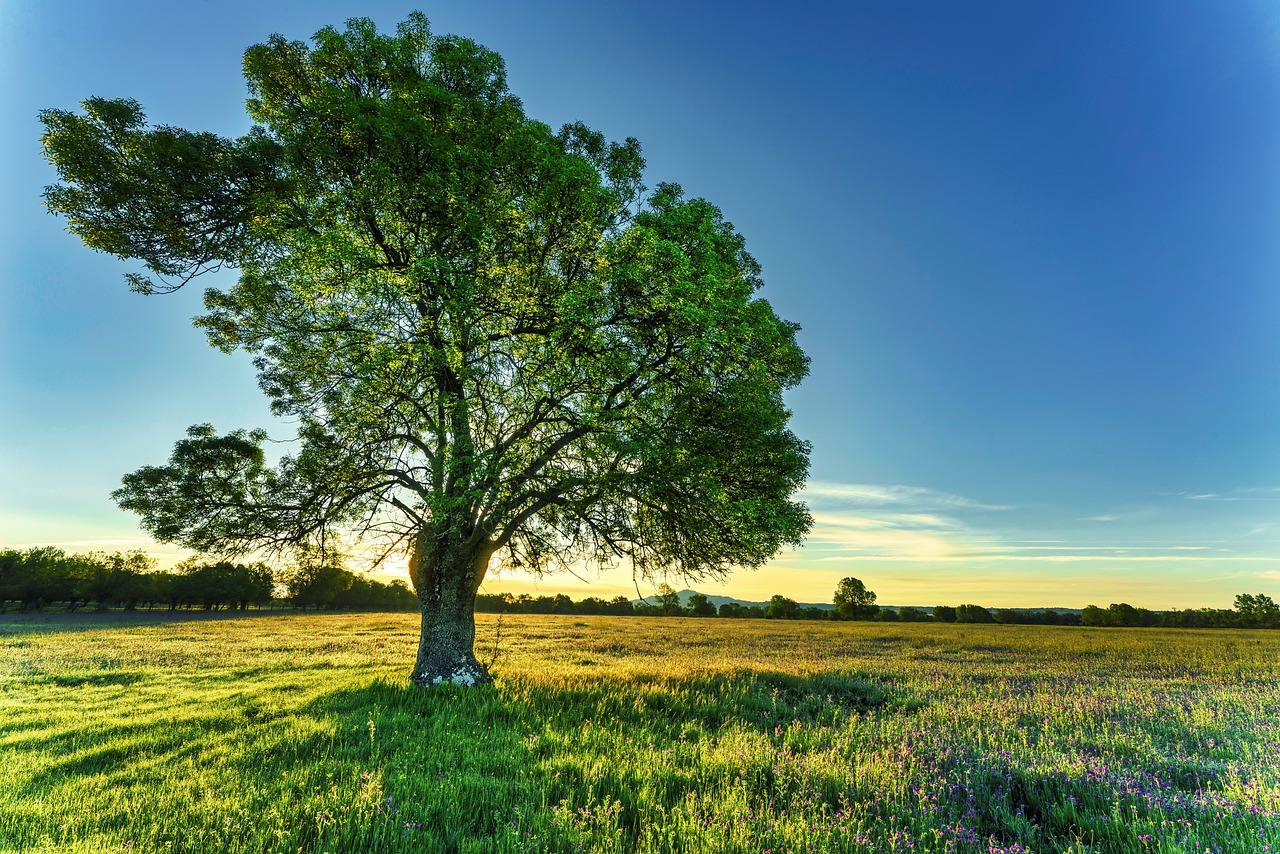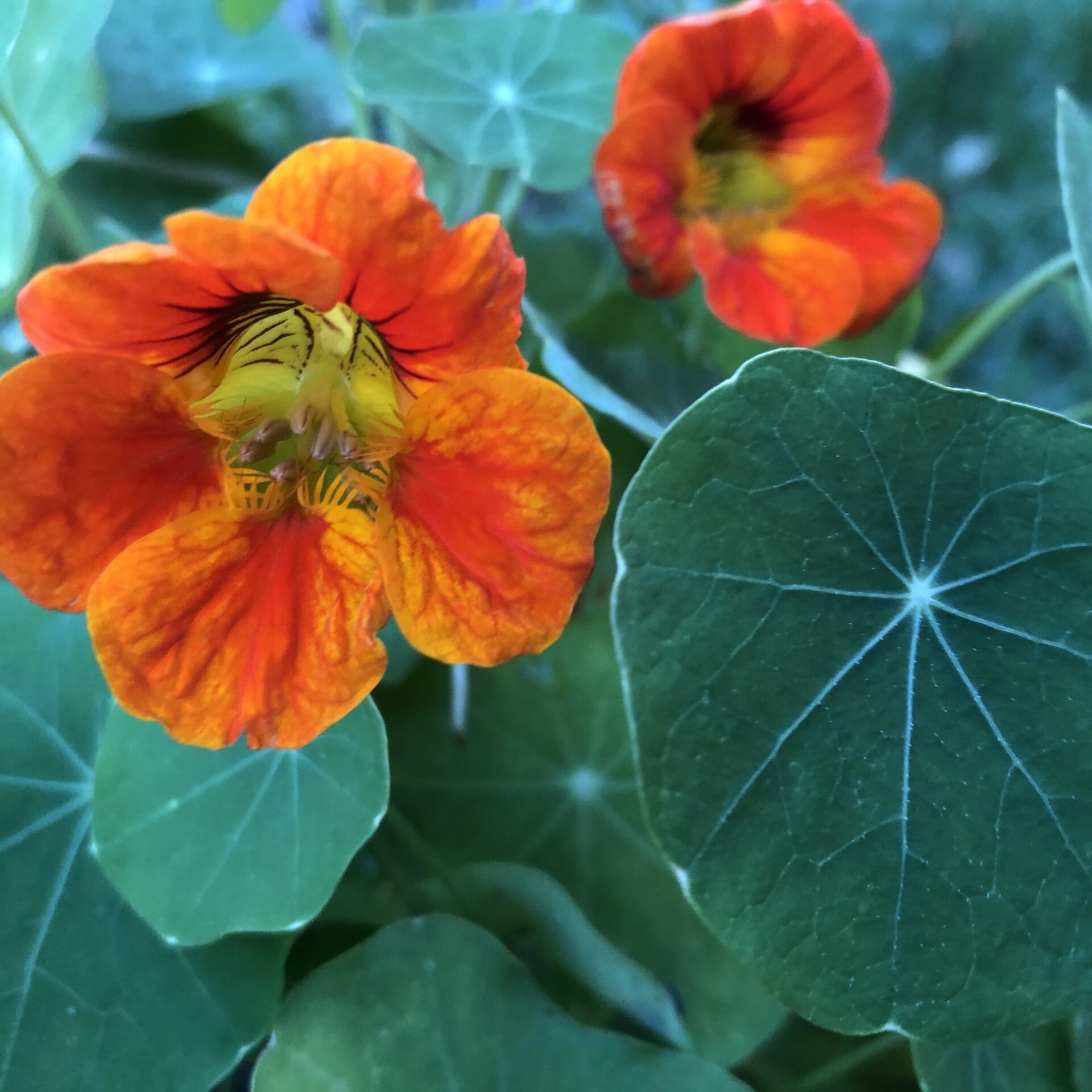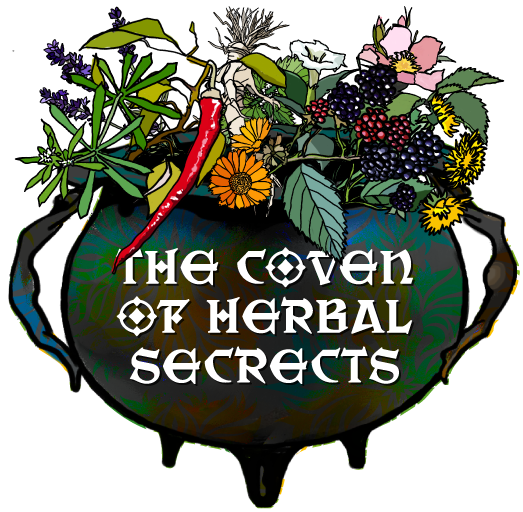As the leaves start to turn into the deep hues of autumn, their work now done, they drop back to the earth to begin the next cycle of death and growth. Their green energy has provided nourishment for seeds and nuts to appear from the flowers and fruits. Amongst the helicopters, burs, hips and haws, the magnificent horse chestnut tree starts to shed his green fruit, which, nestled among the fallen leaves, begins to crack as it dries. The fault line exposes the shiniest nut, which on closer inspection reveals wondrous concentric rings, mountain maps around and around, reflective landscapes in each one. There is nothing like collecting conkers. Peeling off the green, spiky shell, wondering how big the prize inside will be – will it be twins, or one large and one tiny? What autumnal treasures!
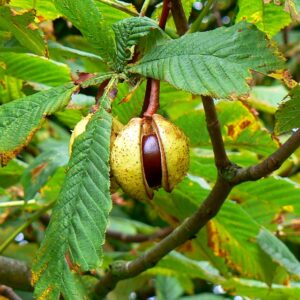 This familiar, large deciduous tree graces many of our parks and green spaces, and most of us have childhood memories of going out to collect the family nuts aka conkers. Opening the green spiky shells to reveal the ever so shiny glorious conker nuts inside, was something we found super exciting as children. Our grandma taught us to make animal figures with them using tooth-picks, also how to soak them in vinegar as a hardening process in preparation for some conker fighting in the playground, an activity that has almost died out in this new ear of health and safely,
This familiar, large deciduous tree graces many of our parks and green spaces, and most of us have childhood memories of going out to collect the family nuts aka conkers. Opening the green spiky shells to reveal the ever so shiny glorious conker nuts inside, was something we found super exciting as children. Our grandma taught us to make animal figures with them using tooth-picks, also how to soak them in vinegar as a hardening process in preparation for some conker fighting in the playground, an activity that has almost died out in this new ear of health and safely,
Our giant childhood friend isn’t native to Britain. This familiar tree arrived in the 16th century, and was grown initially as a specimen tree in collections. Only later did the Horsechesnut begin the process of naturalisation, probably as a result of extensive planting by landscape designers like ‘Capability’ Brown and Sir Christopher Wren, who planted a mile-long avenue of them at Bushy Park, near Hampton Court.
Fabulous Horse Chestnut Facts
- The sticky sap on horse chestnut buds protects them from frost damage and insects.
- Horse chestnut conkers are slightly poisonous to most animals, causing sickness if eaten.
- The annual world conker championship has been held in the village of Ashton, Northants, since 1965.
- ‘Conker’ is derived from the word conch and the children’s game was originally played with snail shells
Medicinal Properties of Conkers
Horse chestnut (Aesculus hippocastanum) is a potent remedy for leg vein health, both for toning and protecting blood vessels. The medicinal marvels of conkers is also super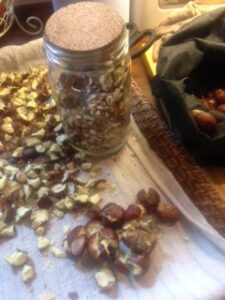 helpful in ankle oedema related to poor venous return. Conker medicine is an anti-inflammatory agent for a variety of conditions, in addition to being used for vascular problems. Prescribed in small doses internally (because of potency) for the treatment of a wide range of venous diseases, including hardening of the arteries, varicose veins, phlebitis, leg ulcers, haemorrhoids and frostbite.
helpful in ankle oedema related to poor venous return. Conker medicine is an anti-inflammatory agent for a variety of conditions, in addition to being used for vascular problems. Prescribed in small doses internally (because of potency) for the treatment of a wide range of venous diseases, including hardening of the arteries, varicose veins, phlebitis, leg ulcers, haemorrhoids and frostbite.
Horsechestnut also has astringent and anti-inflammatory actions and acts by strengthening the vein walls, the lumen, which, when slack or distended, become problematic. The plant reduces fluid retention by increasing the permeability of the capillaries and allowing the re-absorption of excess fluid back into the circulatory system.
The conkers are the source of a saponin known as aescin, which is the compound that has been shown to promote normal tone in the walls of the veins, thereby improving circulation through the veins and promoting the return of blood to the heart.
Varicose Veins and Haemorrhoids
The venous system in the body returns deoxygenated blood from all parts of the body, including the organs, to the right side of the heart and then on to the lungs to be oxygenated. From the lungs, the oxygenated blood passes to the left part of the heart, to be pumped to all the tissues and organs of the body. The venous system consists of large and small veins; the large veins tend to lie alongside arteries. Veins are more thin-walled than arteries, they act as a reservoir for blood, and about 75% of the body’s blood is in the venous system.
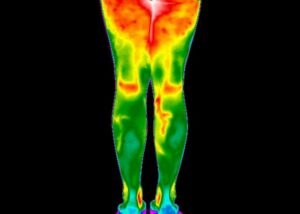 The valves in the veins in the legs can get stretched and damaged by the high pressures that are required to move small hard dry stools. The valves soon become incapable of holding up the blood. Without valves in good working order, a four-foot column of blood presses on the lower veins all day long. One result of this unrelieved pressure is varicose veins, the tortuous blue ‘worms’ which detract so much from the appearance of a person’s legs, often causing pain and sometimes ulcers. The delicate veins in your legs can become damaged by lifestyle; for example poor diet, which can lead to constipation.
The valves in the veins in the legs can get stretched and damaged by the high pressures that are required to move small hard dry stools. The valves soon become incapable of holding up the blood. Without valves in good working order, a four-foot column of blood presses on the lower veins all day long. One result of this unrelieved pressure is varicose veins, the tortuous blue ‘worms’ which detract so much from the appearance of a person’s legs, often causing pain and sometimes ulcers. The delicate veins in your legs can become damaged by lifestyle; for example poor diet, which can lead to constipation.
Similar to varicose veins in causation, if not location, are haemorrhoids. You may have heard people say they got theirs from sitting on cold toilet seats or from having babies. The veins that become haemorrhoids are located in the very last parts of the intestinal tract, called the rectum and the anus. These veins at this terminus of the gut perform the important function of making a tight seal there, by means of blood-filled cushions to prevent faeces and gas from leaking out of the intestine.
The hemorrhoidal veins in the rectum suffer a fate similar to the veins in the legs. Each time veins are filled beyond their normal capacity, stretching them like over-inflated balloons, they become permanently dilated and hang out of the rectum. They become persistent and painful bulges, with the further troublesome symptoms of bleeding and itching. Anyone at any age can be affected by haemorrhoids. Diet has a pivotal role in causing and preventing haemorrhoids. People who consistently eat a high-fibre diet are less likely to get haemorrhoids as they are less likely to get constipation.
As herbalists we see many people with vein problems that can be managed very well with increasing fresh fruit, vegetables, drinking water and exercise. Horse chestnuts are always included somewhere in their prescriptions.
Mythology and Folklore of Horse Chestnut
As conkers are pretty heavy, birds and animals didn’t naturally spread them about, and our giant childhood tree friend isn’t actually native to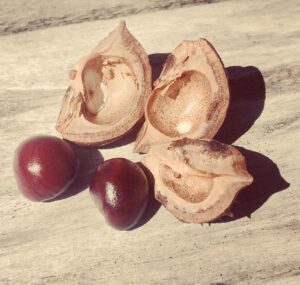 Britain. This familiar tree arrived in the 16th century, and was grown initially as a specimen tree in collections. While the exact etymology of ‘conker’ is not entirely clear, it is believed to have evolved from the dialectal word ‘conquer,’ which means ‘to strike’ or ‘to overcome.’ This usage is a reference to the game of conkers, you might have played as a child (if you are above a certain age…as health and safety now deems this fun game too dangerous!) players take turns trying to strike and break each other’s horse chestnut seeds.
Britain. This familiar tree arrived in the 16th century, and was grown initially as a specimen tree in collections. While the exact etymology of ‘conker’ is not entirely clear, it is believed to have evolved from the dialectal word ‘conquer,’ which means ‘to strike’ or ‘to overcome.’ This usage is a reference to the game of conkers, you might have played as a child (if you are above a certain age…as health and safety now deems this fun game too dangerous!) players take turns trying to strike and break each other’s horse chestnut seeds.
With strong, deep roots and connection to the element of Earth, this magnificent tree helps to promote harmony, balance and to stay grounded. Meditating under a horse chestnut tree can deepen your connection to your inner self through physical and spiritual healing. Similarly, by carrying horse chestnut leaves or twigs, or arranging them on an altar space, can allow you to feel a grounded stability from the tree. Its ability to brave all-weather conditions in combination with a super long lifespan, (up to 300 years) also encourages strength and wisdom.
Aside from the game of conkers, first recorded in 1848 on the Isle of Wight, it was believed that carrying three conkers in your pocket would bring you luck, often by way of money. Being seeds, horse chestnuts came to symbolise a life force by unlocking hidden treasures and dispelling negative energies, and were often applied to protective rituals. The sheer amount of seeds present on our mighty friend represents fertility and abundance with a rich potential for new growth and prosperity.
Other Associations with Horse Chestnut
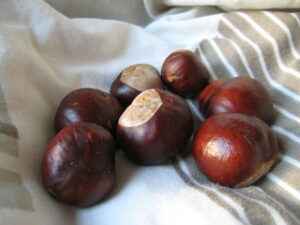 In addition to the spiritual benefits of the horse chestnut tree, historically it was also associated with its physical healing properties, and was believed to help with inflammation, circulation and pain relief. The Encyclopedia of Superstitions, Folklore and Occult Sciences Vol. 2 (1903) by Cora Linn Daniels, states the Belgium’s carried them as a cure for giddiness, while others believed carrying them offered some relief against arthritis.
In addition to the spiritual benefits of the horse chestnut tree, historically it was also associated with its physical healing properties, and was believed to help with inflammation, circulation and pain relief. The Encyclopedia of Superstitions, Folklore and Occult Sciences Vol. 2 (1903) by Cora Linn Daniels, states the Belgium’s carried them as a cure for giddiness, while others believed carrying them offered some relief against arthritis.
Further back in history, it’s said that the Vikings used soaked crushed up conkers to make soap bars. As conkers have saponins, which are soap-like chemicals, they can be added as an ingredient to get clean with soap or shampoos.
And some of us still do! Read more here!
Conker Abundance
You may find that you harvest far too many conkers because they are so beautiful. You can add the remainder to your autumnal Nature table in celebration of this abundant time or crack one open, plant it and see what grows!
Don’t stop reading yet…!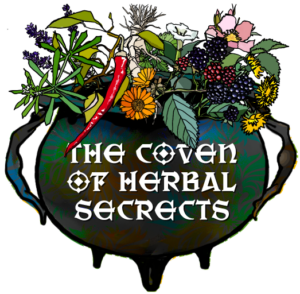
If you want to know the more about The Medicinal Marvels of Conkers, why not join our Coven? You’ll soon have access to our best resources while increasing your confidence and knowledge about the magic of herbs and master the art of herbal remedy creation, spells and rites, plus step by step guides to getting to know your plants better.
Once posted, our article on The Medicinal Marvels of Conkers will cover the topics above more in-depth, plus:
- Medicinal Properties of Conkers
- More info on Varicose Veins and Haemorrhoids
- Conker Gel Recipe
- Conker Tincture Recipe
- Longer Planned Preparation Leaves and Conker Ointment
Plants are calling YOU

